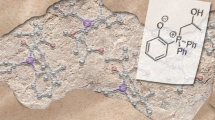Abstract
The electrochemical reduction of 1,1-dihalo-2-R-2-methylcyclopropanes was studied by polarography and preparative electrolysis. A mixture of stereoisomeric monoboro- and monochlorocyclopropanes was obtained with preparative yield of 60–70% in preparative electroreduction in methanol against a background of 0.1 M LiClO4. In the case of bromine derivatives of cyclopropanes (except when R = CN) an effect was found on the part of the current density on the ratio of cis and trans isomers, which was interpreted as a change, in dependence on current density, of the contributions of the reactions of reduction of the starting compounds (SN2 mechanism) and ionic pairs (SN1 mechanism). The effect of the solvent (CHCl3, DMF, DMSO, MeOH) and background salt (LiClO4, Et4NBr) on the ratio of stereoisomers is in agreement with this interpretation.
Similar content being viewed by others
References
J. Y. Becker,Electrochemistry of the Cyclopropyl Group. The Chemistry of the Cyclopropyl Group, Z. Rappoport (ed.) (1987).
S. Patai,The Chemistry of the Carbon-Halogen Bond, Vol. 2 (1973), p. 982.
A. I. D'yachenko, S. F. Savilova, N. A. Abramova, T. Yu. Rudashevskaya, O. A. Nesmeyanova, and O. M. Nefedov,Izv. Akad. Nauk SSSR, Ser. Khim., No. 7, 1688 (1980).
E. V. Dehmlow, M. Lissel, and J. Heider,Tetrahedron Lett., 33, No. 3, 363.
M. M. Latypova, L. V. Katerinich, L. I. Baranova, V. V. Plemenkov, and I. G. Bolesov,Zh. Org. Khim. 18, No. 12, 2552 (1982).
Yu. M. Kargin, V. Z. Kondranina, and M. I. Semakhina,Izv. Akad. Nauk SSSR, Ser. Khim., No. 2, 278 (1971).
H. Ymanaka, R. Oshima, K. Teramura, and T. Ando,J. Org. Chem. 37, No. 11, 1734 (1972).
M. Bakhbukh, Yu. K. Grishin, N. I. Yakushkina, A. A. Formanovskii, and I. G. Bolesov,Dokl. Akad. Nauk SSSR 248, No. 3, 622 (1979).
M. M. Baizer,Organic Electrochemistry, Dekker, New York (1973).
A. I. Fry and R. H. Moore,J. Org. Chem. 33, 1283 (1968).
R. Harard, S. Jaonnet, and A. Tallec,Electrochim. Acta 28, No. 8, 1095 (1983).
Summaries of Reports of All-Union Conference on Mechanisms of Reactions of Nucleophilic Substitution and Addition, Donetsk (1981).
Additional information
A. E. Arbuzov Institute of Organic and Physical Chemistry, Kazan Science Center, Russian Academy of Sciences, Kazan. Translated from Izvestiya Akademii Nauk, Seriya Khimicheskaya, No. 9, pp. 2023–2032, September, 1992.
Rights and permissions
About this article
Cite this article
Kargin, Y.M., Gritsenko, E.I., Yanilkin, V.V. et al. Electrochemical reduction of 1,1-dihalo-2,2-disubstituted cyclopropanes. Russ Chem Bull 41, 1572–1579 (1992). https://doi.org/10.1007/BF00863575
Received:
Issue Date:
DOI: https://doi.org/10.1007/BF00863575




